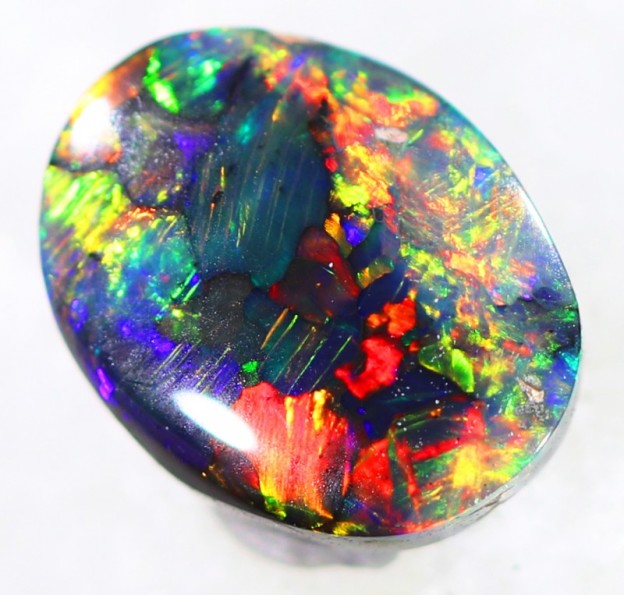PHYSICAL AND OPTICAL PROPERTIES OF OPAL
The term opal refers to a family of minerals composed of silica and water with inclusions of various elements. Its chemical formula is SiO2, nH2O, it is a hydrated silicon dioxide. The proportion of water varies from 1 to 27%. There is no crystalline system. The density of opals varies from 1.98 to 2.50, their hardness on the Mohs scale is 5.5 to 6.5. Under the ultraviolet rays, the opals have a white, yellow, greenish-yellow or green luminescence.
DIFFERENT COLORS AND VARIETIES OF OPALS
There are several varieties of opals. The noble opals, much sought after in jewelery, exhibit a phenomenon of iridescence, that is, they show a play of multicolored flashes of light. They are produced by diffraction of light on silica nanospherules of uniform size and arrangement. Common opals, on the other hand, contain heterogeneous or irregular nanospherules, and therefore have a single color.
Here are some types of opals:
– Fire opal, red hyacinth to fire red, transparent to translucent;
– Milky white opal, milky white to yellow-white or blue-white, translucent with a vitreous luster to matte; some have veinlets and masses of manganese oxide, these are dendritic opals.
– The woody opal consists of trunks or opalized branches. The dark circles of the wood are clearly visible. This opal is fragile.
– The hydrophane (or opal matrix) is white, matte and sticks to the tongue. Rather opaque, it has the property of changing appearance if it plunges into the water. It becomes more transparent and can become more emotional.
– Hyalite has great transparency; it is colorless with slight blue or green shades.
– The jelly opal is gray-blue with some light
Effects – The harlequin opal has beautiful iridescent glitter of all colors, it is very popular.
Healing Crystal Crocoite Stone
The opal is formed when water leaches silica and deposits it on layers of sandy clay during a drought. It is sometimes found instead of shells or bones. The location of the gems in the mine is therefore unpredictable, they must be searched by hand or with small machines to avoid the risk of breaking.
In the past, opals came from Egypt, India or Saudi Arabia. Nowadays, it is Australia that produces 90% of the opals sold in the world, precious gems and very high quality. These deposits were discovered by the German geologist Johannes Menge and 1849. One of them, Lightning Ridge, revealed opalized dinosaur skeletons.
Other opal producing countries are Brazil, Guatemala, Honduras, Indonesia, Japan, Mexico, Russia and the United States.
THE ADVICE OF OUR GEMOLOGIST: HOW TO CHOOSE HIS OPAL?
There are so many kinds of opals, so many different colors that the first criterion of choice obviously remains the tastes of each. However, the value of an opal depends on several criteria:
– the color of the iridescence: the red light effects are the most sought after, then come purple, pink and turquoise, very rare, and finally blue and green , more common.
– The intensity of the iridescence: in general and opal with a less prestigious color than others but with very bright and intense irides will have a price higher than a more sought-after color but with duller flakes.
– Transparency is also an important evaluation criterion, depending on the variety of opals.
– the motif: for example, Yowah’s opals have mosaics of extraordinary colors, which make the stone look like stained glass or cloisonné enamels.
METALS COMMONLY ASSOCIATED WITH OPAL
The wide variety of opals gives free rein to the creativity of jewelers. We see this stone associated with gold, silver and prestigious platinum.
STORIES AND LEGENDS AROUND THE OPAL
The word “opal” comes from the Sanskrit Upala, through the Greek “opallios” which would indicate the color changes.
Some Aboriginal groups in Australia have a very poetic legend in their mythology: the creator god would one day descend on the Earth by sliding on a rainbow. No sooner had he set foot on the ground than all the stones would have sparkled, the same colors as the rainbow…
For Pliny the Elder, the opal was wonderful because it combined the colors and qualities of all other precious stones.
It is said that Marc Antoine dreamed of acquiring the magnificent blue opal of a senator named Nonius, with the aim of offering it to the beautiful Cleopatra. But the senator in question, rather than give up his stone, preferred to choose exile…
In India the opal is the symbol of the Trinity (Trimurti) formed by the creator god Brahma, the conservative Vishnu and the destroyer Shiva.
It has long been considered a lucky charm and present in the treasures of the European Courts. This beautiful reputation was once shattered by the influence of a nineteenth-century novel written by the Scottish Walter Scott, in which a princess is accused of being demonic. She wears an opal on the forehead and, in contact with the holy water, the gem loses all its colors and the princess is in pain … before disappearing, leaving behind only a handful of ashes.
VIRTUES AND BENEFITS OF OPAL
The Greeks believed that opal was a source of hope and a symbol of purity. She was known to increase clairvoyance, to make meditation and reflection easier, to improve intuition.
Today in lithotherapy, we continue to attribute these virtues to opal. It calms and soothes, promotes love and tenderness, improves the sentimental life of Gemini and Aquarius. It opens the spirit to spiritual life and restores vitality to tired people.
ASTROLOGICAL CORRESPONDENCE OF OPAL
Opal is the birthstone of people born in October. It is associated with several astrological signs: aquarius, gemini, fish, cancer, virgin … in Chinese astrology, it is the stone of the Serpent: it has mysterious depths, gives endurance and courage, and makes … invisible.

